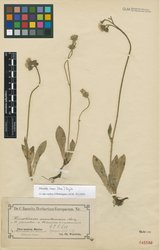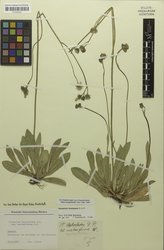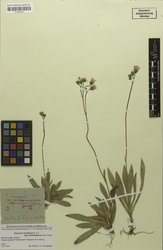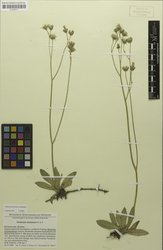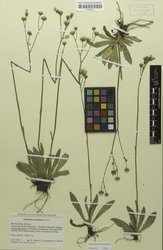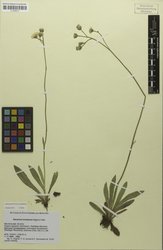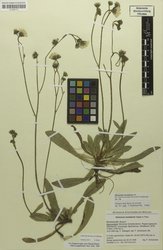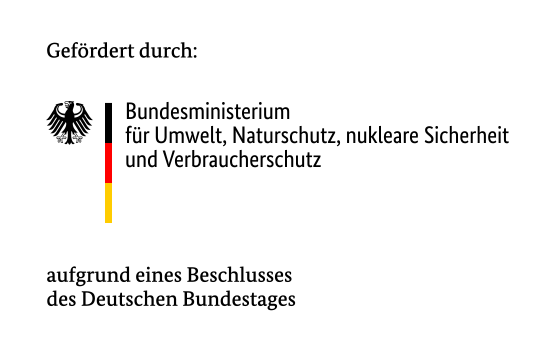Wissenschaftlicher Name
Pilosella chomatophila (Peter) Gottschl.
Synonyme
Hieracium chomatophilum Peter
Pilosella austrobavarica Schuhw.
Hieracium montanum Nägeli & Peter
Pilosella inops auct.
Pilosella austrobavarica Schuhw.
Hieracium montanum Nägeli & Peter
Pilosella inops auct.
Deutscher Name
Berg-Mausohrhabichtskraut
Morphologische Stellung
erythrochrista > officinarum
teils stabile Zwischenart, teils Primärbastard
In der 20. und 21. Auflage des Rothmalers (Bräutigam 2011, 2016) wurde die Sippe noch unter dem Namen P. inops (Peter) Soják geführt. Hieracium inops Peter wurde jedoch als Gartenbastard "flagellaris-piloselloides" beschrieben und meint damit eine Sippe, die nicht in dem Umfang von P. chomatophila eingeschlossen ist (Gottschlich 2020c).
In der 20. und 21. Auflage des Rothmalers (Bräutigam 2011, 2016) wurde die Sippe noch unter dem Namen P. inops (Peter) Soják geführt. Hieracium inops Peter wurde jedoch als Gartenbastard "flagellaris-piloselloides" beschrieben und meint damit eine Sippe, die nicht in dem Umfang von P. chomatophila eingeschlossen ist (Gottschlich 2020c).
Anmerkung zur Verbreitung
S-BY, Münchener Schotterebene (stark zurückgegangen)
Standort
Magerrasen, Ruderalstellen
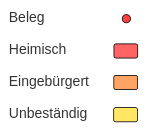
Wuchshöhe (cm)
20–50 (–65)
Ausläufer
fehlend
Flagellen
zahlreich vorhanden
Grundblätter
etwas bläulichgrün, länglich-lanzettlich, ± spitz, äußere oft fast spatelig
Grundblattoberseite
± zerstreut borstig behaart; ohne Sternhaare
Grundblattunterseite
± zerstreut borstig behaart; ± reich sternhaarig
Stängelblätter
0–2
Stängel
zerstreut bis reich behaart, Haare dunkel, steif, 2–4 mm lg.; oben mäßig, nach unten abnehmend drüsig; zerstreut bis mäßig sternhaarig
Kopfstand
locker rispig; mit 3–10 (–25) Köpfen
Kopfstiele
haarlos bis zerstreut, dunkel behaart; bis reich drüsig; graufilzig sternhaarig
Hülle
(6,5–) 7–9 mm lg.; unbehaart; reich großdrüsig; mäßig bis reich sternhaarig (Rand der Hüllblätter meist ohne Sternhaare); Hüllblätter schmal bis breitlich, spitz, oft schwarz, ± hellrandig
Blüten
gelb, äußere bisweilen rotstreifig
Weitere Merkmale
Blütezeit
6 (–7)
Chromosomenzahl
2n = 4x = 36
Ähnliche Arten
Syntypus zu Hieracium montanum (JSTOR Global Plants)
Syntypus zu Hieracium montanum (JSTOR Global Plants)
Syntypus zu Hieracium montanum (JSTOR Global Plants)
Syntypus zu Hieracium montanum (JSTOR Global Plants)
Syntypus zu Hieracium montanum (JSTOR Global Plants)
Syntypus zu Hieracium montanum (JSTOR Global Plants)
Syntypus zu Hieracium montanum (JSTOR Global Plants)
FloraWeb
Global Biodiversity Information Facility
Syntypus zu Hieracium montanum (JSTOR Global Plants)
Syntypus zu Hieracium montanum (JSTOR Global Plants)
Syntypus zu Hieracium montanum (JSTOR Global Plants)
Syntypus zu Hieracium montanum (JSTOR Global Plants)
Syntypus zu Hieracium montanum (JSTOR Global Plants)
Syntypus zu Hieracium montanum (JSTOR Global Plants)
FloraWeb
Global Biodiversity Information Facility
Wesenberg, J. & Bräutigam, S. 2017 (aktualisiert 2024). Pilosella Hill. In: Dressler, S., Gregor, T., Hellwig, F. H., Korsch, H., Wesche, K., Wesenberg, J. & Ritz, C. M. Bestimmungskritische Taxa zur Flora von Deutschland. Herbarium Senckenbergianum Frankfurt/Main, Görlitz & Herbarium Haussknecht Jena. [online] http://webapp.senckenberg.de/bestikri
